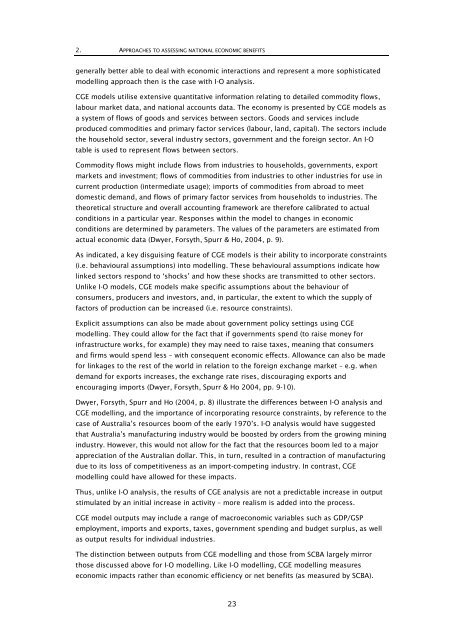Research 350 - NZ Transport Agency
Research 350 - NZ Transport Agency
Research 350 - NZ Transport Agency
Create successful ePaper yourself
Turn your PDF publications into a flip-book with our unique Google optimized e-Paper software.
2. APPROACHES TO ASSESSING NATIONAL ECONOMIC BENEFITS<br />
generally better able to deal with economic interactions and represent a more sophisticated<br />
modelling approach then is the case with I-O analysis.<br />
CGE models utilise extensive quantitative information relating to detailed commodity flows,<br />
labour market data, and national accounts data. The economy is presented by CGE models as<br />
a system of flows of goods and services between sectors. Goods and services include<br />
produced commodities and primary factor services (labour, land, capital). The sectors include<br />
the household sector, several industry sectors, government and the foreign sector. An I-O<br />
table is used to represent flows between sectors.<br />
Commodity flows might include flows from industries to households, governments, export<br />
markets and investment; flows of commodities from industries to other industries for use in<br />
current production (intermediate usage); imports of commodities from abroad to meet<br />
domestic demand, and flows of primary factor services from households to industries. The<br />
theoretical structure and overall accounting framework are therefore calibrated to actual<br />
conditions in a particular year. Responses within the model to changes in economic<br />
conditions are determined by parameters. The values of the parameters are estimated from<br />
actual economic data (Dwyer, Forsyth, Spurr & Ho, 2004, p. 9).<br />
As indicated, a key disguising feature of CGE models is their ability to incorporate constraints<br />
(i.e. behavioural assumptions) into modelling. These behavioural assumptions indicate how<br />
linked sectors respond to ‘shocks’ and how these shocks are transmitted to other sectors.<br />
Unlike I-O models, CGE models make specific assumptions about the behaviour of<br />
consumers, producers and investors, and, in particular, the extent to which the supply of<br />
factors of production can be increased (i.e. resource constraints).<br />
Explicit assumptions can also be made about government policy settings using CGE<br />
modelling. They could allow for the fact that if governments spend (to raise money for<br />
infrastructure works, for example) they may need to raise taxes, meaning that consumers<br />
and firms would spend less – with consequent economic effects. Allowance can also be made<br />
for linkages to the rest of the world in relation to the foreign exchange market – e.g. when<br />
demand for exports increases, the exchange rate rises, discouraging exports and<br />
encouraging imports (Dwyer, Forsyth, Spurr & Ho 2004, pp. 9-10).<br />
Dwyer, Forsyth, Spurr and Ho (2004, p. 8) illustrate the differences between I-O analysis and<br />
CGE modelling, and the importance of incorporating resource constraints, by reference to the<br />
case of Australia’s resources boom of the early 1970’s. I-O analysis would have suggested<br />
that Australia’s manufacturing industry would be boosted by orders from the growing mining<br />
industry. However, this would not allow for the fact that the resources boom led to a major<br />
appreciation of the Australian dollar. This, in turn, resulted in a contraction of manufacturing<br />
due to its loss of competitiveness as an import-competing industry. In contrast, CGE<br />
modelling could have allowed for these impacts.<br />
Thus, unlike I-O analysis, the results of CGE analysis are not a predictable increase in output<br />
stimulated by an initial increase in activity – more realism is added into the process.<br />
CGE model outputs may include a range of macroeconomic variables such as GDP/GSP<br />
employment, imports and exports, taxes, government spending and budget surplus, as well<br />
as output results for individual industries.<br />
The distinction between outputs from CGE modelling and those from SCBA largely mirror<br />
those discussed above for I-O modelling. Like I-O modelling, CGE modelling measures<br />
economic impacts rather than economic efficiency or net benefits (as measured by SCBA).<br />
23
















